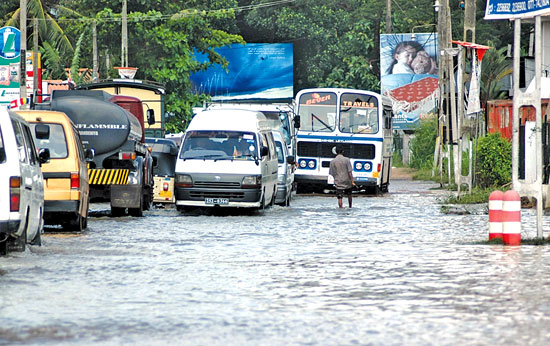The Urban reality
Flooding after every downpour, the downside of
mindless urbanization:
by Rukshana Rizwie
The catastrophic flooding in Chennai which inundated its
international airport for days and left thousands homeless, is a stark
reminder that the built environment doesn’t do well in the rain.
 |
|
- www.ecobusiness.com |
Similarly, shorter spells of rain, intense downpours and a little
over two inches of rain overnight can bring Colombo to a crippling
standstill. Urban flooding in Colombo is chronic and costly, experts
opine. While the underlying causes continues to be blatantly ignored.
“The fact remains that mindless development and urbanisation over the
last few decades including the reclaiming of lowlands and choking of
storm water drains as well as other avenues for water flow is conducive
to floods,” explained Dr Rangajeewa Rathnayake, who heads the Department
of Town & Country Planning at the University of Moratuwa.
Speaking of the current context, Dr Rathnayake said that it was
evident the authorities had abandoned the concept of storm water drains
– an essential instrument in fighting floods when it came to
construction and urbanisation.
“Storm water drains in Colombo have been in existence for decades,
however we’ve observed that their linkage to water bodies and
topographical data of the water flow are rarely seen as part of the
whole system,” he said. “As a result of such poor urban planning the use
of the system is ignored and man-made systems are of no match.”
Excessive construction he explained has led to poor recharge of
groundwater aquifers and blocking of natural drainage systems. Storm
water drainage systems on the other hand are either clogged or closed
off.
Drainage channels
“Freehold land space or water bodies which was once used to retain
rainwater are now multi-structured buildings or recreational sites,” he
said citing that such water bodies and lakes has a natural flood
discharge channel which can drain the spillover. “If all such water
retention spaces are filled, water overflows.”
He further said that water log data are not deemed important since
many constructors are compelled to complete projects within a short span
of time before funds run dry.
“At present we do not have standards or regulations to prevent the
blocking of such drainage channels,” he said. “Even if there are any,
its not being followed.” Dr. Rathnayake explained that there needs to be
increased awareness among the general public about how they are
continuously contributing to the problem. “Even when it comes to
building a wall, there is a reason why you require the council’s
approval. A wall is a permanent structure which blocks water flow.”
He referred to housing schemes citing of how so many of them are
quickly deluged in water after a short spell of rain.
World Bank Metro Colombo Urban Development Project
The World Bank embarked on an ambitious project three years ago
funding it to a tune of USD 213 million in a bid to reduce flooding in
the Colombo basin and improve local infrastructure to mitigate the
floods.
The team leader of the project who is currently in Sri Lanka in an
email said that the project has completed “demonstrative initiatives
through local authorities such as the rehabilitation of existing roads,
drainage and canal systems to channel out excessive water from the
Colombo basin,” adding that “these short term measures have begun to
show benefits in reducing of floods.”
Based on the World Bank report, even though the Colombo Metropolitan
Region covers only about 6 percent of the country’s total land area and
is home to 28 percent of its population, it accounts for almost 50
percent of the national GDP and 80 percent of industrial value.
Clogged canals
Elaborating on the floods situation, they added that the drainage
system is obsolete and needs to be improved and expanded while the
canals are clogged with garbage and encroachments, the wetlands, which
play a very important role in maintaining this balance, have been either
filled or not managed adequately - reducing its ability to store excess
water.
Climate change has also led to shifts in the rainfall patterns. To
address the issue of flooding in Colombo would require comprehensive
approach and long term measures.
Asian Development Bank gives While in Paris for the COP21, the Asian
Development Bank has agreed to fund USD 435 million as part of a USD 675
million project to construct two new reservoirs and 260 kilometres of
canals that will upgrade the existing reservoirs across the country.
The extra water will also be funnelled into existing hydro-power dams
to generate 250 MW of new electricity.
This particular project is expected to commence next year in February
and be completed by 2024. |

